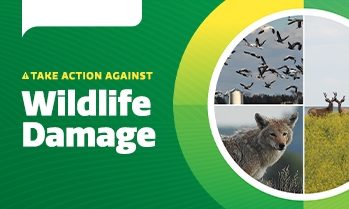Terms and Conditions - Bee Mortality Insurance Program
This program was developed as a result of co-operative efforts between the Saskatchewan Crop Insurance Corporation (SCIC), the Saskatchewan Beekeepers Development Commission (SBDC), Saskatchewan Ministry of Agriculture, Agriculture and Agri-Food Canada and individual beekeepers.
These terms and conditions set out special conditions of bee mortality insurance to help you understand the coverage provided. Please refer to your endorsement, coverage detail and statement of insurance forms for specific premium and coverage information.
Insurance Features
- Bee Mortality insurance is available for commercial beekeepers, with a minimum of 100 colonies, in Saskatchewan.
- Beekeepers must be registered with the Saskatchewan Beekeepers Development Commission.
- Beekeepers will have to apply for a contract of insurance by March 31.
- The deadline to endorse or remove Bee Mortality (overwintering insurance) is June 25.
- The Bee Mortality insurance program is based on an individual deductible that is calculated using a combination of the beekeepers individual overwintering loss experience and/or the provincial long-term average.
- To provide beekeepers with deductibles based on individualized loss experience, verifiable documentation is required.
- New beekeepers with no experience will start at the provincial long-term average deductible.
- Insurance is available at the base value per hive less the deductible amount in the event of a claim.
- All colonies will be subject to a fall inspection by SCIC to assess the hive’s “winter readiness.” Only colonies that meet industry standard criteria at the time of inspection will be insurable.
- The minimum insurable wintering size is 8 frames.
- All eligible colonies must be insured.
- Coverage will begin after the fall inspection by SCIC and will continue until the colonies are inspected in the spring.
- In the spring, beekeepers with a concern about winter survival must notify SCIC, for an adjuster to inspect and determine losses, prior to colonies being unwrapped, cleaned up or moved outside. If spring losses are in excess of the deductible level, the claim will be paid at the insured value.
- Weak colonies (less than three frames) will be paid at 50 per cent. Dead colonies will be paid at 100 per cent.
- Number of bees: Frames 75% - 100% covered with bees.
- Under the Bee Mortality Insurance Program, May 15 is the deadline to notify SCIC of any loss that occurred over the winter months. If SCIC is not notified of a loss by this date, coverage is terminated.
Beekeeping Practices
Producers are advised to follow best management practices as stated in the Beekeeping in Western Canada Manual published in 1998, by Alberta Agriculture, Food and Rural Development. Producers are also advised to consult with the Ministry of Agriculture’s Provincial Apiculture Specialist for the most current and recommended beekeeping practices for overwintering bees in Saskatchewan.
Failure to follow recommended practices may result in the reduction or denial of any claim, should a loss occur. Producers are advised of the following specific considerations:
- Insurance will not be provided for colonies overwintered outside the province of Saskatchewan.
- Prior to bees going into winter, the following industry standards must be met or exceeded:
- Health standards for Varroa mite and Nosema levels must be met. Records of treatment must be provided to SCIC at the time of inspection.
- Strength of colonies for doubles, singles, indoor/outdoor must meet industry standards.
- Sufficient feed to last the winter must be provided to the colony.
- All winter procedures must meet industry standards for Saskatchewan.
- To be eligible for insurance, inspected colonies must be at or below the prescribed levels:
| Date | Varroa Mite Levels |
|---|---|
| September 7 or before | 1 per cent (0.01 mites per bee) |
| September 8 to September 14 | 2 per cent (0.02 mites per bee) |
| After September 14 | 3 per cent (0.03 mites per bee) |
- If mite infestations exceed the prescribed level on the date of inspection, colonies must be treated with the product as listed below, or if the beekeeper chooses to use an alternate mite control method, the mite levels must be reduced to less than 2 per cent upon re-inspection. Re-inspection will occur three to four weeks after the initial inspection.
- Insurance for colony losses due to outside temperatures, as a result of removing from indoor storage too early, may be reduced or denied.
- In consultation with the industry and Ministry of Agriculture, SCIC has determined that the current recommended follow-up product is Apivar, applied as directed by the label.







